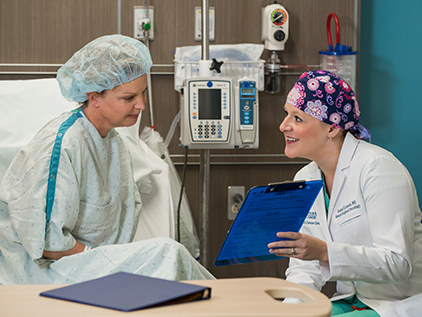- Home
- Conditions and Care
- Treatments
- Reconstructive Surgery
- Breast Reconstruction
- Tissue-Based Flap Breast Reconstruction
Breast Reconstruction
Tissue-Based Flap Breast Reconstruction
The University of Kansas Health System offers tissue-based, or “flap,” breast reconstruction for women in Kansas City who want to create their new breasts using their own tissue. This approach uses skin, muscle and fat from the body to sculpt and shape new breasts that look and feel very natural.
There are several types of tissue-based breast reconstruction. Choosing the best option for your needs requires a thorough evaluation from our specialists.
What is tissue-based breast reconstruction?
Tissue-based breast reconstruction uses your own natural tissue to reconstruct 1 or both breasts. An alternative to implant-based breast reconstruction, flap breast reconstruction is a complex surgery that can offer an excellent final result.
We offer a variety of appointment types. Learn more or call 913-588-1227 to schedule now.
Who can have flap breast reconstruction?
Women who have lost 1 or both breasts to breast cancer or other trauma may benefit from breast reconstruction. Those who are good candidates for tissue-based reconstruction:
- Do not want, or are not candidates for, implant reconstruction
- Have had failed implant reconstruction
- Have sufficient donor site tissue to create 1 or both breasts
- Are emotionally prepared and have realistic expectations
How does tissue-based breast reconstruction work?
Tissue-based reconstruction can be performed in 2 ways.
Your surgeon will help you determine which approach is best for you. You will also decide where tissue will be taken from your body to create your new breasts. Your options include the back, buttocks, stomach or thighs.

Cancer care you can count on
The University of Kansas Cancer Center is 1 of fewer than 60 NCI-designated comprehensive cancer centers in the nation, and it's part of The University of Kansas Health System.
Benefits and risks of tissue-based breast reconstruction
Breast reconstruction using your own tissue has advantages and drawbacks. Compared to implant-based breast reconstruction, tissue-based breast reconstruction:
- Is a more complex and invasive procedure
- Requires a longer recovery time and hospital stay
- Is costlier than breast implants
However, the results of tissue-based reconstruction often look and feel more natural. Plus, because you are not putting a synthetic object in your body, you avoid the risk of implant-related complications like capsular contracture. Tissue-based breast reconstruction also has a lower risk of complications for people who need radiation therapy.
What happens during tissue-based breast reconstruction?
Breast reconstruction using autologous tissue is a major surgery that will be conducted in a hospital setting using general anesthesia. You may be encouraged to perform certain exercises to strengthen muscle and to improve blood supply in donor area in the weeks leading up to surgery.
The specific surgical steps will vary depending on the location of the donor site tissue. Generally speaking, skin and fat are used to reconstruct the new breast. The donor tissue may be tunneled to the chest, or completely removed and replanted, depending on the technique your surgeon uses.
You can expect to recover in the hospital for the first few days after surgery so your care team can track your progress. The drains inserted during surgery to help prevent fluid buildup are removed after approximately 1 week. Prior to surgery you should arrange for someone to help you for the first weeks after your return home from the hospital. Recovery can last 4-6 weeks, depending on your health prior to surgery and the extent of the procedure.

Still the best
Our hospital continues to rank as the best in Kansas City and in Kansas according to U.S. News & World Report.

Magnet-recognized
The University of Kansas Hospital has been designated a Magnet® facility by the American Nurses Credentialing Center since 2006. 
Respect for all people
Named a leader in LGBTQ+ Healthcare Equality by the Human Rights Campaign.